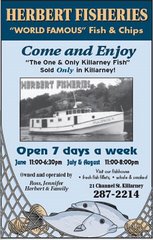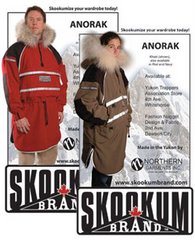
Our kennel is set amongst the trees, about 50 feet from our front door. We have cleared most of the trees from the inside of the kennel, so that the dogs will have sun exposure in the winter and there is more of a breeze in the summer months, which will hopefully cut down on blackflies and mosquitoes. The kennel itself is a fenced enclosure with a gate at the front and a gate at the back. This allows us to harness the dogs and hook them up to the sled in the kennel itself, and when we come back from a run, we can close both gates and let the dogs loose as we unharness and them and put them back at their house.
Each of our dogs has a house, which is full of straw in the winter and wood shavings in the summer. They have a chain that is 6' long which is attached to a post with a swivel. This gives them roughly 113 square feet of 'territory.' Each post is 11.5 feet apart and the posts are in rows, so the dogs can socialize with their neighbours, but they can't breed. Having rows makes kennel chores easier; up one side to feed, down the other. Up one side to scoop poop, down the other. Up one side to harness ... and so on. I'd like to take this time to discuss the issues involved with chains and free-running dogs.
When we first got involved with dogs, we thought that we'd like to have them all loose in a large pen. While it was nice to see them playing, we had some dogs that didn't like each other, which necessitated the building of a second and then a third pen, just to accomodate the grumpier dogs. At the outset, it would seem the ideal way to keep dogs, but the longer we used this system, the less impressed we were with it. We encountered several problems with it that we thought needed to be addressed. We noticed that our dogs were developing a pecking order, and when it came time to feed them, the lower dogs were chased off their food by the more assertive dogs. We also found it difficult to clean. Since the run was through the trees and undergrowth, it was difficult to find and remove all their waste. Even if all of it could be found, it was impossible to identify whose was whose. While this may seem trivial to some, it is important to us because their feces is a good indicator of their health. Not knowing whose is whose does not let us diagnose the dogs properly and we may miss a health issue. A good example of this is one of our new aquisitions had a fairly large infestation of worms. Since he has his own spot, we were able to notice and treat the problem rather quickly and we have seen a great improvement in his personality and his performance. This would not have been possible in a free-run system where we would have had to deworm all the dogs and this is hard on their systems, not to mention costly to us.
When we first moved to the Yukon and set our dogs up, we did not have a fence around our dogs. That didn't last long as the neighbour dogs were loose and they would come over and harass and try to fight with ours. The fence was not long in going up. Since moving we have put up a fence again not so much to keep the dogs in but, rather, to keep things out. We have porqupines here and other small mammals, but more importantly, we have wolves. Last year, a friend of ours had a dog killed and partially eaten by a wolf and this was not an isolated incident. Many local dog owners lost dogs or had dogs maimed as a result of wolf attacks.
The dogs get fed twice a day. I feed them a broth in the morning, which is just warm water mixed with some sort of meat. Last week, it was ground moose that a co-worker gave to me, since it was freezer burned. This week, it is pork that I managed to salvage from work as well. When it was -50 a few weeks ago, we fed them pure pork fat, which is like putting coal on a fire: their internal furnace converts the fat to almost pure heat, so it was not unusual to see the dogs laying out in the sun, even though the temperature was -50 or lower. In the evening, they get a scoop of kibble and a scoop of water in their dish. It is important to keep them well-hydrated, so we try and give them lots of water. Some old-school dog owners are of the opinion that the dogs can eat snow for their daily water intake but this is a difficult way to get water since snow is converted to water at roughly the rate of 20:1. Plus, to melt the snow into water, the dog needs to use its body heat and when the temperatures are cold, it is dangerous to take away body heat.
Once the dogs are fed, I make the rounds again, picking up after each dog. This means that to just feed and clean up after the dogs, I am in the kennel about 730 times a year.
To store our food, both kibble and meat products, we use an old decomissioned freezer that was given to us by a local appliance store. We store most of our dog-related things in the kennel, and we are hoping to build a better shed and covered structure when the weather permits so that we can keep our straw dry and better organize everything.
Hopefully, this has explained a little bit about our kennel set up.
 "Happiness is not achieved by the conscious pursuit of happiness; it is generally the by-product of other activities"
- Aldous Huxley
"Happiness is not achieved by the conscious pursuit of happiness; it is generally the by-product of other activities"
- Aldous Huxley



1 comment:
so, do you name the puppies? :)
peace,
zayne
Post a Comment